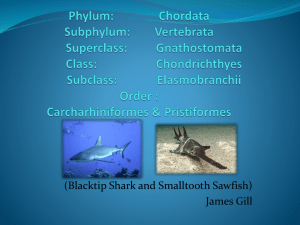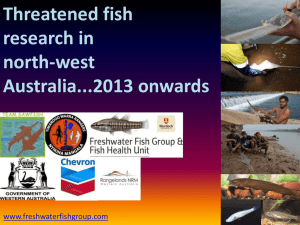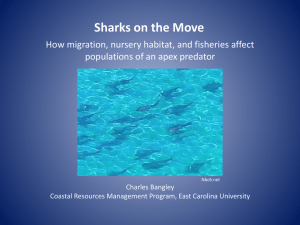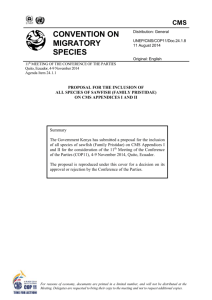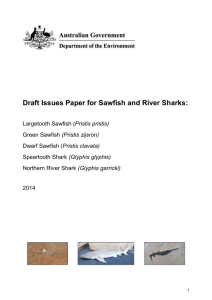Word - 132KB - Department of the Environment
advertisement
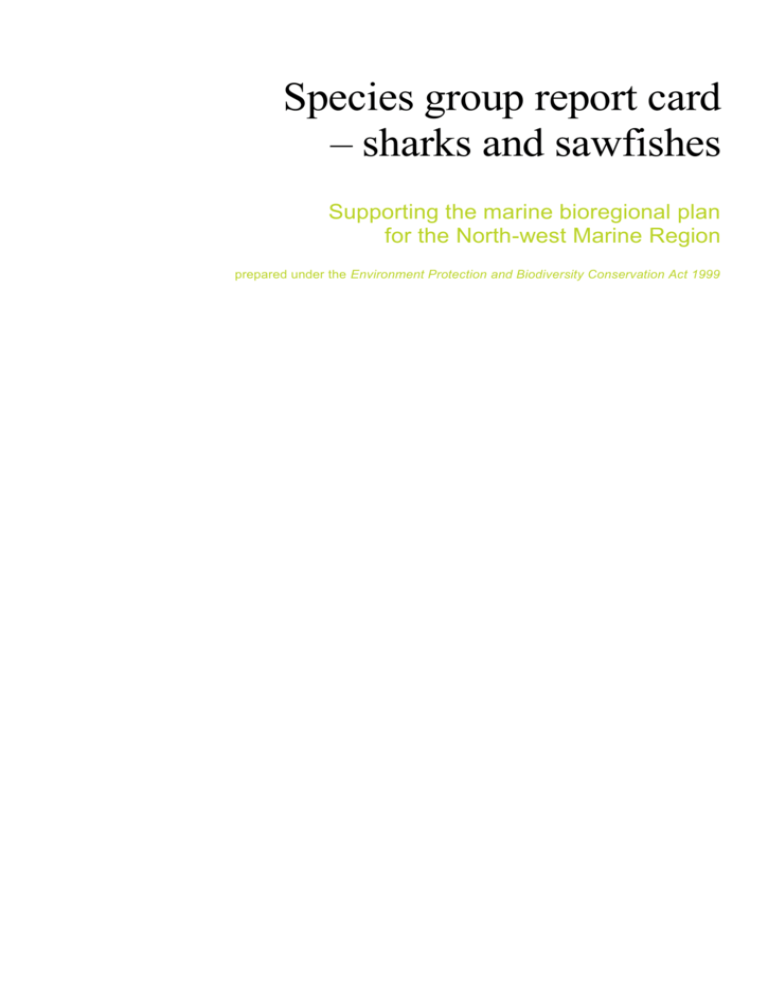
Species group report card – sharks and sawfishes Supporting the marine bioregional plan for the North-west Marine Region prepared under the Environment Protection and Biodiversity Conservation Act 1999 Disclaimer © Commonwealth of Australia 2012 This work is copyright. Apart from any use as permitted under the Copyright Act 1968, no part may be reproduced by any process without prior written permission from the Commonwealth. Requests and enquiries concerning reproduction and rights should be addressed to Department of Sustainability, Environment, Water, Population and Communities, Public Affairs, GPO Box 787 Canberra ACT 2601 or email public.affairs@environment.gov.au CONTENTS Species group report card – sharks and sawfishes .................................................................. 1. Sharks and sawfishes of the North-west Marine Region ............................................................ 2. Vulnerabilities and pressures ....................................................................................................... 3. Current protection measures ........................................................................................................ References ....................................................................................................................................... Attachment 1: Sharks and sawfishes occurring in the North-west Marine Region .............. SPECIES GROUP REPORT CARD – SHARKS AND SAWFISHES Supporting the marine bioregional plan for the North-west Marine Region prepared under the Environment Protection and Biodiversity Conservation Act 1999 Report cards The primary objective of the report cards is to provide accessible information on the conservation values found in Commonwealth marine regions. This information is maintained by the Department of Sustainability, Environment, Water, Population and Communities and is available online through the department’s website (www.environment.gov.au). A glossary of terms relevant to marine bioregional planning is located at www.environment.gov.au/marineplans. Reflecting the categories of conservation values, there are three types of report cards: species group report cards marine environment report cards heritage places report cards. While the focus of these report cards is the Commonwealth marine environment, in some instances pressures and ecological processes occurring in state waters are referred to where there is connectivity between pressures and ecological processes in state and Commonwealth waters. Species group report cards Species group report cards are prepared for large taxonomic groups that include species identified as conservation values in a region; that is, species that are listed under Part 13 of the Environment Protection and Biodiversity Conservation Act 1999 (EPBC Act) and live in the Commonwealth marine area for all or part of their lifecycle. All listed threatened, migratory and marine species and all cetaceans occurring in Commonwealth waters are protected under the EPBC Act and are identified in the relevant marine bioregional plans as conservation values. Species group report cards focus on species for which the region is important from a conservation perspective; for example, species of which a significant proportion of the population or an important life stage occurs in the region’s waters. For these species, the report cards: outline the conservation status of the species and the current state of knowledge about its ecology in the region define biologically important areas; that is, areas where aggregations of individuals of a species display biologically important behaviours assess the level of concern in relation to different pressures. 1. Sharks and sawfishes of the North-west Marine Region The North-west Marine Region has a rich fauna of cartilaginous fish (sharks and rays) owing to the diversity of marine environments found across its waters. Of the approximately 500 shark species found worldwide, 94 are found in the region—19 per cent of the world’s shark species (DEWHA 2008). Four species of cartilaginous fish listed under the EPBC Act are known to occur in the North-west Marine Region: grey nurse shark, white shark, whale shark and green sawfish. Two other species of listed cartilaginous fish may infrequently occur in the region (Attachment 1). Of the cartilaginous fishes known to occur in the North-west Marine Region, this report card focuses on the six species listed in Table 1. These species were selected following consideration of their conservation status, distribution and population structure within the region, life history characteristics and the potential for the populations in the region to be genetically distinct from populations elsewhere. Sawfishes North-western Australia probably represents some of the last relatively healthy populations of sawfish in the world (Stevens et al. 2008). The dwarf sawfish, Pristis clavata, freshwater sawfish, Pristis microdon, and green sawfish, Pristis zijsron, occur mainly in inshore coastal waters and riverine environments of tropical northern Australia (Pillans et al. 2010). The freshwater sawfish and green sawfish are wider-ranging in the Indo-west Pacific, while the dwarf sawfish has been confirmed only from northern Australian waters. Given considerable declines in the global (and Australian range) of sawfishes, northern and north-west Australia may contain the last significant populations of these sawfishes. Important areas for sawfishes adjacent to the North-west Marine Region include the Pilbara coast, King Sound, and lower reaches of the Fitzroy, May and Robinson rivers for the dwarf sawfish; King Sound, and the Fitzroy, Durack, Robinson and Ord rivers for the freshwater sawfish; and Cape Keraudren for the green sawfish (Stevens et al. 2008; Thorburn et al. 2003, 2007, 2008). Sawfishes generally inhabit inshore coastal, estuarine and riverine environments. The dwarf sawfish is primarily a coastal and estuarine species and juveniles appear to use estuarine waters only (Thorburn et al. 2008). There is, however, a single record from a riverine environment, more than 100 kilometres from the estuary (Thorburn et al. 2003). The freshwater sawfish has been recorded in north-west Australia from rivers (including isolated water holes), estuaries and marine environments (Stevens et al. 2005). Newborns and juveniles primarily occur in the freshwater reaches of rivers and in estuaries, while most adult freshwater sawfish have been recorded in marine and estuarine environments (Peverell 2005; Thorburn et al. 2007). It is believed that mature freshwater sawfish enter less saline waters during the wet season to give birth (Peverell 2005) and freshwater river reaches play an important role as nursery areas. The green sawfish has predominantly been recorded in inshore coastal areas, including estuaries and river mouths with a soft substrate, although there have been records of sawfish offshore in depths up to 70 metres (Stevens et al. 2005). This species does not occupy freshwater habitats. Short-term tracking of movement patterns has shown that dwarf sawfish occupy a range within the coastal fringe of only a few square kilometres and show site fidelity (Stevens et al. 2008). The species spends slack high tide resting in mangrove areas and becomes active on mud and sand flats during tidal movement, presumably feeding (Stevens et al. 2008). Short‑ term tracking has shown that green sawfish appear to have limited movements that are tidally influenced, and they are likely to occupy a restricted range of only a few square kilometres within the coastal fringe, with a strong association with mangroves and adjacent mudflats (Stevens et al. 2008). Sawfishes feed close to the benthos on a variety of teleost fishes and benthic invertebrates, including cephalopods, crustaceans and molluscs (Compagno & Last 1999; Last & Stevens 2009; Pogonoski et al. 2002; Thorburn et al. 2007, 2008). Grey nurse shark Grey nurse sharks (Carcharias taurus) are listed as separate populations under the EPBC Act. The west coast population is listed as vulnerable and the east coast population is listed as critically endangered. The western subpopulation has been recorded from the North West Shelf in the north, to Cocklebiddy in the south (RB McAuley, unpublished data). Grey nurse sharks are most commonly found on, or close to, the bottom of the continental shelf, from close inshore to depths of about 200 metres (McAuley 2004). The grey nurse shark is more commonly found in temperate waters. The North-west Marine Region represents the northern limit of the west coast population. Grey nurse sharks feed primarily on a variety of teleost and elasmobranch fishes and some cephalopods (Gelsleichter et al. 1999; Smale 2005). Reef-associated benthic and deeper shelf fishes are all consumed (Smale 2005). Details of movement patterns of the western subpopulation are unclear (McAuley 2004), but the eastern subpopulation undergoes north– south seasonal movements related to breeding, forming aggregations at critical rocky reef sites (Bansemer & Bennett 2009). Although aggregation sites have not been formally identified off the west coast (Chidlow et al. 2006), a reliable, but unconfirmed, account of at least one aggregation in the North-west Marine Region has been reported (RB McAuley, unpublished data). Whale shark Whale sharks (Rhincodon typus) are listed as vulnerable under the EPBC Act. They have a widespread distribution in tropical and warm temperate seas, both oceanic and coastal (Last & Stevens 2009). The species is widely distributed in Australian waters, most commonly at Ningaloo Marine Park in Western Australia and to a lesser extent at Christmas Island and in the Coral Sea. The species is generally encountered close to or at the surface, as single individuals or occasionally in schools or aggregations of up to hundreds of sharks. Whale sharks also dive to great depths (at least 980 metres) (Wilson et al. 2006). Whale sharks are migratory and undergo seasonal movements that have been associated with productivity pulses, ocean circulation and water temperatures, and they regularly appear where seasonal food pulses are known to occur. Ningaloo Reef is the main known aggregation site for whale sharks in Australian waters and has the largest density of whale sharks per kilometre in the world (Martin 2007). Whale sharks aggregate at Ningaloo between March and June each year to feed on krill and baitfishes (Wilson et al. 2006). The North-west Marine Region is therefore important to whale sharks for foraging. Whale sharks tracked by satellite from north-west Australia have been shown to move in a northerly, north-easterly or north-westerly direction towards or into Indonesian waters (Sleeman et al. 2010; Wilson et al. 2006). There appears to be spatial and seasonal segregation of whale shark populations according to size and sex. For example, coastal aggregations such as at Ningaloo Reef contain a high frequency of immature males (Meekan et al. 2006). Whale sharks are one of three species of planktivorous sharks and feed on a variety of plankton and nekton (Last & Stevens 2009). It is unknown when and where whale sharks breed. White shark White sharks (Carcharodon carcharias) are listed as vulnerable under the EPBC Act. The species is primarily temperate with northern ranges off north-west Australia (CMAR 2011; Last & Stevens 2009). There are no known aggregation sites for white sharks in the North-west Marine Region, and this species is most likely to be found south of North West Cape, probably in low densities (Environment Australia 2002b). However, recent research is providing new insight into seasonal movement patterns along the west coast of Australia into the North-west Marine Region (CMAR 2011). White sharks have been recorded travelling northwards during spring and appear to return to southern waters during the summer (CMAR 2011). Sharks travelling up the west coast probably live in the Great Australian Bight for some of the year (CMAR 2011). International mixing of populations has also been demonstrated, with one white shark making a transoceanic migration from South Africa to the North-west Marine Region (Bonfil et al. 2005). Smaller white sharks (less than 3 metres in length) feed primarily on teleost and elasmobranch fishes, broadening their diet as larger sharks to include marine mammals (Last & Stevens 2009). The exact diet in north -west Australia is unknown, but movements into the region may be related to prey availability (CMAR 2011). Sharks that have been tracked moving up the west coast of Australia have been subadults (CMAR 2011), and there is little information on reproductive activities in Australian waters (pupping grounds have not been id entified in Australia). Biologically important areas Biologically important areas are areas that are particularly important for the conservation of the protected species and where aggregations of individuals display biologically important behaviours such as breeding, foraging, resting or migration. The presence of the observed behaviour is assumed to indicate that the habitat required for the behaviour is also present. Biologically important areas have been identified for some EPBC Act listed species found in the North-west Marine Region, using expert scientific knowledge about species’ distribution, abundance and behaviour in the region. The selection of species was informed by the availability of scientific information, the conservation status of listed species and the importance of the region for the species. The range of species for which biologically important areas are identified will continue to expand as reliable spatial and scientific information becomes available. Biologically important areas have been identified for four species of shark and sawfish: whale shark, freshwater sawfish, green sawfish and dwarf sawfish. Behaviours used to identify biologically important areas for shark and sawfishes include foraging, nursing and pupping. Biologically important areas are included in the North-west Marine Conservation Values Atlas (www.environment.gov.au/cva). 2. Vulnerabilities and pressures Vulnerabilities Cartilaginous fish as a group are characterised by their ‘limited’ life history (late age at maturity, slow growth rate, low fecundity, longevity, low rate of natural mortality), which results in restricted productivity. Subsequently, they have a limited capacity to recover from population depletion. White sharks, grey nurse sharks and sawfishes are all viviparous, giving birth to well-developed live young, but there are many gaps in our knowledge of population dynamics, particularly of sawfishes. This precludes assessment of the species’ reproductive capacity and hence resilience to depletion. The grey nurse shark has one of the lowest reproductive rates known among the chondrichthyans, giving birth to a maximum of two pups every second or third year (Bansemer & Bennett 2009). In white sharks, the development of young is slow, with a gestation period estimated to be 18 months; the 2–17 young are large when born (around 1.3 metres in length) (Last & Stevens 2009). Only a single pregnant whale shark has ever been examined, and she contained about 300 pups (Joung et al. 1996). Litter size is not known for dwarf and freshwater sawfish. Freshwater environments have been identified as important nursery habitats for sawfish (Peverell 2005; Pillans et al. 2010; Thorburn et al. 2007). This physically restrictive environment limits their ability to evade exploitation and the alteration of their habitat (Compagno & Cook 1995) and therefore makes freshwater sawfish more susceptible to the impacts of human pressures. Occurring in freshwater environments (identified as important nursery habitat; Peverell 2005; Pillans et al. 2010; Thorburn et al. 2007) adds to the susceptibility of freshwater sawfish to the impacts of human pressures; this physically restricted environment limits their ability to evade exploitation and the alteration of their habitat (Compagno & Cook 1995). Repeated use of small areas of habitat has been demonstrated in dwarf sawfish and green sawfish (Stevens et al. 2008) and renders these species susceptible to localised depletion. In the case of the freshwater sawfish, dry season riverine habitat can retract into a series of pools, reducing available habitat, and increasing susceptibility to pressures. A recent study found that populations of green, freshwater and possibly dwarf sawfish in north-west Australia may have different maternal populations to those occurring in the Gulf of Carpentaria (Phillips et al. 2011). This would make local populations more vulnerable to decline as females would not be replenished from stocks elsewhere. Analysis of pressures On the basis of current information, pressures have been analysed for the six cartilaginous species discussed in this report card. A summary of the pressure analysis for sharks and sawfishes is provided in Table 1. Only those pressures identified as of concern or of potential concern are discussed in further detail below. An explanation of the pressure analysis process, including the definition of substantial impact used in this analysis, is provided in Part 3 and Section 1.1 of Schedule 1 of the plan. Table 1: Outputs of the shark and sawfish species pressure analysis for the North-west Marine Region Species Pressure Source Sea level rise Climate change Changes in sea Climate change Sawfishes (3 species) Grey nurse shark (west coast population) Whale shark White shark temperature Chemical pollution/ Urban development contaminants Agricultural activities Nutrient pollution Urban development Agricultural activities Marine debris Shipping Fishing vessels Land-based activities Noise pollution Seismic exploration vessels (other) Physical habitat Dredging modification Dredge spoil Urban/coastal development Offshore construction and installation of infrastructure Human presence at Tourism sensitive sites Recreation and charter fishing (burleying) Research Legend of concern of potential concern of less concern not of concern data deficient or not assessed Table 1: Outputs of the shark and sawfish species pressure analysis for the North-west Marine Region Species Pressure Source Extraction of living Illegal, unregulated and resources unreported fishing Sawfishes (3 species) Grey nurse shark (west coast population) Whale shark White shark Commercial fishing (non-domestic) Commercial fishing (domestic) Recreational fishing Indigenous Commercial fishing (prey depletion) Bycatch Commercial fishing (domestic) Recreational fishing Collision with vessels Shipping Tourism Fishing Invasive species Shipping Fishing vessels Land-based activities Changes in Land-based activities hydrological regimes Legend of concern of potential concern of less concern not of concern data deficient or not assessed Sawfishes Sea level rise—climate change Sea level rise as a result of climate change is of potential concern for sawfishes in the North‑ west Marine Region. Sea level has been rising at approximately 7.1 millimetres per year in the North-west Marine Region since the 1990s, the largest increase in Australia (National Tidal Centre 2010). Global sea levels have risen by 20 centimetres between 1870 and 2004 and predictions estimate a further rise of 5–15 centimetres by 2030, relative to 1990 levels (Church et al. 2009). Longer term predictions estimate increases of 0.5 to 1.0 metre by 2100, relative to 2000 levels (Climate Commission 2011). The main concern with sea level rise is the potential consequences when sea level rise is combined with increasing cyclone frequency (Climate Commission 2011; DCC 2009). Predictions for the North-west Marine Region in 2100 are for a hundred-fold increase in extreme sea level events in the Pilbara and up to a thousand-fold increase in the Kimberley (DCC 2009). Predicting the consequences of climate change for sawfishes is difficult. Very little is known about the species; basic population information is lacking, and their adaptive capacity is unknown. However, rising sea level will have significant effects on coastal habitats, including increasing salinity in estuaries and the lower reaches of creeks and rivers, and altering geophysical processes of erosion and deposition along the coastal zone. Mangroves may decline in some areas but expand in others by replacing salt marsh and freshwater wetland habitats (Chin & Kyne 2007). Sawfish species use estuarine and freshwater habitats for key life stages (Pillans et al. 2010; Stevens et al. 2008) and some sawfishes are known to use mangrove habitat (Stevens et al. 2008). There is evidence that salinity influences species distributions of northern Australian estuarine sharks (Thorburn et al. 2003). Given the fairly restrictive habitat ranges of sawfish species, it is likely that changes in key habitats will have adverse impacts on these species. In an analysis for the Great Barrier Reef region, sawfishes were ranked as moderately vulnerable overall to climate change, with high exposure to the effects of rising sea levels (Chin et al. 2010). Marine debris—shipping; fishing boats; other vessels; land-based activities Marine debris from shipping, fishing boats, other vessels and land-based activities is of potential concern for sawfishes in the North-west Marine Region. Northern Australia is vulnerable to marine debris given the proximity of intensive fishing operations, difficulties in surveillance and enforcement of existing management arrangements, and ocean circulation patterns that are likely to concentrate floating debris before dumping it on coastlines and beaches (Kiessling 2003). The North-west Marine Region is susceptible to marine debris due to the illegal, unregulated and unreported fishing that occurs adjacent to the region. Large amounts of fishing net are discarded or lost from the fisheries of the Arafura Sea (Limpus 2009). Because of their saw-like rostrum, sawfishes are particularly susceptible to entanglement in marine debris (Seitz & Poulakis 2006). Such entanglement can cause serious or fatal injury. The occurrence of sawfish species in popular recreational fishing locations may expose them to discarded fishing line and other debris. Offshore, they may interact with larger marine debris. The overall impact of marine debris on sawfish populations is unknown. However, there are records of fatal impacts on individual sawfishes outside the region (Ceccarelli 2009) and management measures have not been successful in significantly reducing marine debris in other areas. Bycatch—commercial and recreational fishing Bycatch from commercial and recreational fishing is of concern for sawfishes in the North-west Marine Region. Capture of sawfish species is generally prohibited in Western Australian and Commonwealth waters. However, commercial fishing has been identified as the major threat to sawfish species (Pillans 2007; Stevens et al. 2005; Stevens et al. 2008) and substantial declines in several species have been attributed to this pressure (Stevens et al. 2005). Entanglement in commercial fishing nets is considered the main threat to sawfish populations in northern Australia (Stevens et al. 2008). Some species, including dwarf sawfish and green sawfish, have limited tidally influenced movements and are particularly vulnerable to any net fishing operations when they are actively feeding on mud and sand flats (Stevens et al. 2008). The rostrum of sawfish makes them particularly susceptible to capture in all forms of net fishing gear (Stevens et al. 2008). Within Western Australia, there is commercial gillnetting for barramundi and king salmon at King Sound, Cambridge Gulf, Eighty Mile Beach and the Joseph Bonaparte Gulf. While incidental capture rates in commercial fisheries are generally low, sawfish mortality from bycatch in gillnets has been about 50 per cent of captured individuals (Field et al. 2008). Such mortality is considered unacceptable for sawfishes, given their conservation status. Post-release mortality can also occur as a result of capture and handling, although post-release survival rates will be higher for larger, safely released sawfishes (FSERC 2009; Salini et al. 2007). A number of management measures have been implemented but without population data, it is unknown whether these measures have been effective in contributing to any recovery of populations. Despite the protected status of sawfish species, there is potential for mortality from recreational fishing. Recreational fishing is a popular activity in the North-west Marine Region, although most effort tends to be concentrated in waters adjacent to population centres. Recreational fishing continues to grow in popularity, and with a growing population in this region due to expansion of the resource sector, improvements in technology, and larger recreational boats giving greater access to the coast, more remote areas are now becoming more accessible. This will result in increased overlap between recreational fishing activities and the distribution of sawfish, which will increase the potential mortality from incidental catches. Observations of dead, discarded sawfish from recreational fishing highlight that mortality occurs as a direct result of capture and discarding (Stevens et al. 2005; Thorburn et al. 2003). Given the suspected small population sizes and restricted habitats (for example, dwarf sawfish and green sawfish have been shown to repeatedly use restricted areas of habitat; Stevens et al. 2008), these species are all vulnerable to localised depletion from incidental mortality. Elsewhere, post-release mortality has been suggested to be the largest source of recreational fishing mortality of elasmobranchs (Lynch et al. 2009), and damage from capture and handling or from retained fishing line and hooks may cause post-release mortality in sawfishes. Changes in hydrological regimes—land-based activities Changes in hydrological regimes as a result of land-based activities are of concern for sawfishes in the North-west Marine Region. Neonate and juvenile sawfish species use estuarine and/or freshwater environments, and the latter is an important nursery area for freshwater sawfish. It is thought that pupping in all northern Australian sawfish species coincides with the monsoonal wet season (Peverell 2005; Pillans et al. 2010; Whitty et al. 2008). Wet season freshwater flows are thought to be the cue for sawfishes entering less saline water to give birth (Peverell 2005). Whitty et al. (2008) demonstrated that the number of new recruits of freshwater sawfish captured in the dry season of each year is significantly correlated to higher water levels during the late wet season. Alteration of flow could change the timing of reproduction and the numbers of recruits. Australian tropical rivers have highly energetic, episodic flows related to the monsoonal wet season that transport sediments downstream with little trapping of materials in waterways (Brodie & Mitchell 2005). Barriers and impoundments on rivers can cause siltation and a reduction in saltwater intrusion, and restrict upstream and downstream movements of sawfish. Riverine habitat of freshwater sawfish is often restricted to isolated pools during the dry season, reducing available habitat. Any further reduction of dry season flows would further restrict habitat availability. An additional future threat is the proposed damming of tidal creeks for tidally generated electricity (DEWHA 2009). Whale shark Changes in sea temperature—climate change Changes in sea temperature as a result of climate change are of potential concern for whale shark in the North-west Marine Region. Climate change has the potential to change water temperature and oceanographic currents, thereby significantly affecting the availability of prey and consequently the distribution of whale sharks. Sea temperatures have warmed by 0.7 ºC between 1910–1929 and 1989–2008, and current projections estimate ocean temperatures will be 1 ºC warmer by 2030 (Lough 2009). Although there is little empirical data on effects of climate change on whale sharks, there is some evidence to suggest that the abundance of whale sharks at Ningaloo is correlated to various climatic conditions; therefore changes in climate could potentially alter this relationship. Wilson et al. (2001) suggest there is a positive, but complex correlation between the Southern Oscillation Index, strength of the Leeuwin Current, coastal water temperature, and abundance of whale sharks off Ningaloo Reef. Larger numbers of whale sharks are present during La Niña years than El Niño years. It is possible that changes in oceanographic processes and temperature as a result of climate change could magnify the climate-related seasonal abundance of whale sharks at Ningaloo. Productivity at Ningaloo Reef is influenced by the southward-flowing Leeuwin Current and northerly flowing Ningaloo Current. The Leeuwin Current flows stronger and closer to shore during autumn and winter—the peak sighting period for whale sharks at Ningaloo Marine Park. It is suggested that the Ningaloo Current circulates the waters in the region of Ningaloo Reef and drives productivity in the region at this time (Taylor & Pearce 1999). This circulation of nutrients, combined with localised upwellings and the synchronised timing of spawning events for species such as coral on the Ningaloo Reef, contributes to the influx of whale sharks to the region. Any modification of currents as a result of climate change would likely have implications for not only whale sharks but the whole Ningaloo ecosystem. Whale sharks are usually encountered in waters where the surface temperature is between 21 °C and 25 °C with upwellings of colder water and a salinity range of 34 to 34.5 parts per thousand (Colman 1997). These conditions may produce local concentrations of the plankton and nekton on which whale sharks feed (Colman 1997). Climate change modelling predicts that ocean warming will cause large southward shifts in the distribution of many tropical and subtropical zooplankton, displacing many local species, as well as earlier annual appearance of many groups (Hobday et al. 2006). As zooplankton are such a critical food source for higher trophic levels, both these impacts will alter trophic and competitive relationships among species and disrupt food webs (Hobday et al. 2006). Alterations in the seasonal abundance and distribution of plankton at Ningaloo Reef could influence the abundance of whale sharks and the timing of their annual migration. Extraction of living resources—commercial fishing (non-domestic) Extraction of living resources by non-domestic commercial fishing is of potential concern for whale shark in the North- west Marine Region. Recent evidence indicates that overseas fishing pressure may be the primary cause of perceived recent declines in whale shark numbers (Bradshaw et al. 2007; Bradshaw et al. 2008). Fishery data for whale shark, although scarce, points to a decline in seasonal catches, with the declines occurring in a limited time period since the establishment of directed commercial fisheries in, for example, the Philippines (DEH 2005b). Indonesia has the largest chondrichthyan fishery in the world; however, chondrichthyan catches are largely under-reported or unreported and, as a result, the total landings probably far exceed those reported by Indonesia (White & Cavanagh 2007). Trade in whale shark products is largely driven by demand in Asia for meat and fins. Whale sharks are fully protected in Australian waters, but because whale sharks roam internationally, apparent declines in seasonal sightings may be due to unsustainable fishing in other parts of the whale sharks’ range. It is unclear how successful current protective legislation is due to under-reporting of catches and illegal poaching in range states (i.e. Taiwan, Philippines, Indonesia, the Maldives, Pakistan). The rapid change in population composition over a decade (less than one whale shark generation) supports the hypothesis of unsustainable mortality in other parts of their range (e.g. through overfishing), rather than the alternative of long-term abiotic or biotic shifts in the Australian marine environment (Bradshaw et al. 2008). Consequently, the continued direct and illegal, unregulated and unreported take of whale sharks in other range states is likely to negatively affect the Australian population. Whale sharks are easy to capture and have a widespread distribution in small highly mobile populations, which increases their susceptibility to overexploitation. Slow growth rates, late maturity and delayed infrequent reproduction means that population reduction due to overfishing is likely, and that recovery will be slow (Meekan et al. 2006; Stewart & Wilson 2005). 3. Relevant protection measures Dwarf sawfish, freshwater sawfish, green sawfish, grey nurse shark, whale shark and white shark are listed as vulnerable under the EPBC Act. Under the Act it is generally an offence to kill, injure, take, trade, keep or move listed marine, migratory or threatened species on Australian Government land or in Commonwealth waters without a permit. The dwarf and green sawfish species are listed on Appendix I of the Convention on International Trade in Endangered Species (CITES). The freshwater sawfish, whale shark and white shark are listed on Appendix II, which regulates and monitors any international trade in the species. Alongside the EPBC Act, a broad range of sector-specific management measures to address environmental issues and mitigate impacts apply to activities that take place in Commonwealth marine areas. These measures give effect to regulatory and administrative requirements under Commonwealth and state legislation for activities such as commercial and recreational fishing, oil and gas exploration and production, ports activities and maritime transport. In some instances, as in the case of shipping, these measures also fulfil Australia’s obligations under a number of international conventions for the protection of the marine environment from pollution and environmental harm. Protection and conservation measures administered under the EPBC Act and relevant to the conservation values described in this report card are listed below. EPBC Act conservation plans and action plans Conservation Overview and Action Plan for Australian Threatened and Potentially Threatened Marine and Estuarine Fishes (Pogonoski, Pollard & Paxton 2002) International measures Australia is a signatory to the following international agreements for the conservation of sharks and sawfishes: Convention on International Trade in Endangered Species of Wild Fauna and Flora (CITES)—www.cites.org International Plan of Action for the Conservation and Management of Sharks (IPOA – Sharks)— ftp://ftp.fao.org/docrep/fao/006/x3170e/X3170E00.pdf Memorandum of Understanding on the Conservation of Migratory Sharks— www.cms.int/species/sharks/MoU/Migratory_Shark_MoU_Eng.pdf For more information on conservation listings under the EPBC Act, and related management objectives and protection measures, visit the following sites: www.environment.gov.au/epbc/protect/species-communities.html (listed threatened species) www.environment.gov.au/epbc/protect/migratory.html (listed migratory species) www.environment.gov.au/cgi-bin/sprat/public/sprat.pl (species profile and threats database). REFERENCES Bansemer, CS & Bennett, MB 2009, ‘Reproductive periodicity, localised movements and behavioural segregation of pregnant Carcharias taurus at Wolf Rock, southeast Queensland, Australia’, Marine Ecology Progress Series, vol. 374, pp. 215–227. Bonfil, R, Meÿer, M, Scholl, MC, Johnson, R, O’Brien, S, Oosthuizen, H, Swanson, S, Kotze, D & Paterson, M 2005, ‘Transoceanic migration, spatial dynamics, and population linkages of white sharks’, Nature, vol. 310, pp. 100–103. Bradshaw, CJA, Mollet, HF & Meekan, MG 2007, ‘Inferring population trends for the world’s largest fish from markrecapture estimates of survival’, Journal of Animal Ecology, vol. 76, pp. 480–489. Bradshaw, CJA, Fitzpatrick, BM, Steinberg, CC, Brook, BW & Meekan, MG 2008, ‘Decline in whale shark size and abundance at Ningaloo Reef over the past decade: the world’s largest fish is getting smaller’, Biological Conservation, vol. 141, pp. 1894–1905. Brodie, JE & Mitchell, AW 2005, ‘Nutrients in Australian tropical rivers: changes with agricultural development and implications for receiving environments’, Marine and Freshwater Research, vol. 56, pp. 279–302. Ceccarelli, DM 2009, Impacts of plastic debris on Australian marine wildlife, report by C&R Consulting for the Australian Government Department of the Environment, Water, Heritage and the Arts, Canberra. Chidlow, J, Gaughan, D & McAuley, R 2006, Identification of Western Australian grey nurse shark aggregation sites, final report to the Australian Government Department of the Environment and Heritage, Fisheries research report no. 155, Department of Fisheries, Western Australia. Chin, A & Kyne, PM 2007, ‘Vulnerability of chondrichthyan fishes of the Great Barrier Reef to climate change’, in JE Johnson & PA Marshall (eds), Climate change and the Great Barrier Reef: a vulnerability assessment, Great Barrier Reef Marine Park Authority, Townsville and Australian Greenhouse Office, Canberra, pp. 393–425. Chin, A, Kyne, PM, Walker, TI & McAuley, RB 2010, ‘An integrated risk assessment for climate change: analysing the vulnerability of sharks and rays on Australia’s Great Barrier Reef’, Global Change Biology, vol. 16, pp. 1936–1953. Church JA, White, NJ, Hunter, JR, McInnes, K & Mitchell, W 2009, ‘Sea level’, in ES Poloczanska, AJ Hobday & AJ Richardson (eds), A marine climate change impacts and adaptation report card for Australia 2009, National Climate Change Adaptation Research Facility. Climate Commission 2011, The critical decade: climate science, risks and responses, Australian Government Department of Climate Change and Energy Efficiency, Canberra. CMAR (CSIRO Marine and Atmospheric Research) 2011, New insights into white shark movements in Australia, CMAR, Hobart, viewed 8 April 2011, <www.cmar.csiro.au/whitesharks/ozmovements.html#temp>. Colman, JG 1997, ‘A review of the biology and ecology of the whale shark’, Journal of Fish Biology, vol. 51, pp. 1219– 1234. Compagno, LJV & Cook, SF 1995, ‘The exploitation and conservation of freshwater elasmobranchs: status of taxa and prospects for the future’, Journal of Aquariculture and Aquatic Sciences, vol. 12, pp. 62–90. Compagno, LJV & Last, PR 1999, ‘Order Pristiformes. Pristidae: sawfishes’, in KE Carpenter & VH Niem (eds), FAO species identification guide for fishery purposes – the living marine resources of the western central Pacific, vol. 3, Batoid fishes, chimaeras and bony fishes, part 1 (Elopidae to Linophyroidae), FAO, Rome, pp. 1410–1417. DCC (Australian Government Department of Climate Change) 2009, Climate change risks to Australia’s coasts: a first pass national assessment, DCC, Canberra. DEH (Australian Government Department of the Environment and Heritage) 2005b, Whale shark (Rhincodon typus) recovery plan: issues paper, DEH, Canberra. DEWHA (Australian Government Department of Environment, Water, Heritage and the Arts) 2008, North-west Marine Region bioregional profile: a description of the ecosystems, conservation values and uses of the North-west Marine Region, DEWHA, Canberra, viewed 3 April 2011, <www.environment.gov.au/coasts/mbp/north-west/>. DEWHA (Australian Government Department of Environment, Water, Heritage and the Arts) 2009, Green sawfish (Pristis zijsron), freshwater sawfish (Pristis microdon), speartooth shark (Glyphis sp. A) and northern river shark (Glyphis sp. C) multi species recovery plan – draft issues paper, DEWHA, Canberra. Environment Australia 2002b, White shark (Carcharodon carcharias) recovery plan, Environment Australia, Canberra. Field, IC, Charters, R, Buckworth, RC, Meekan, MG & Bradshaw, CJA 2008, Distribution and abundance of Glyphis and sawfishes in northern Australia and their potential interactions with commercial fisheries, final report May 2008, Commonwealth of Australia, Canberra. FSERC (Freshwater Sawfish Expert Review Committee) 2009, Report of the freshwater sawfish Pristis microdon scientific workshop of 24 March 2009, Brisbane, Australian Government Department of the Environment, Water, Heritage and the Arts, Canberra. Gelsleichter, J, Musick, JA & Nichols, S 1999, ‘Food habits of the smooth dogfish, Mustelus canis, dusky shark, Carcharhinus obscurus, Atlantic sharpnose shark, Rhizoprionodon terraenovae, and the sand tiger, Carcharias taurus, from the northwest Atlantic Ocean’, Environmental Biology of Fishes, vol. 54, pp. 205–217. Hobday, AJ, Okey, TA, Poloczanska, ES, Richardson, AJ & Kunz, TJE 2006, Impacts of climate change on Australian marine life: report to the Australian Greenhouse Office, Australian Government Department of the Environment and Heritage, Canberra. Joung, S-J, Chen, C-T, Clark, E, Uchida, S & Huang, WYP 1996, ‘The whale shark, Rhincodon typus, is a livebearer: 300 embryos found in one “megamamma” supreme’, Environmental Biology of Fishes, vol. 46, pp. 219–223. Kiessling, I 2003, Finding solutions: derelict fishing gear and other marine debris in Northern Australia, National Oceans Office, Hobart, viewed April 2001, <www.environment.gov.au/coasts/mbp/publications/north/pubs/marine-debrisreport.pdf>. Last, PR & Stevens, JD 2009, Sharks and rays of Australia, 2nd edn, CSIRO Publishing, Collingwood. Limpus, C 2009, A biological review of Australian marine turtles, Queensland Environmental Protection Agency, Brisbane. Lough, JM 2009, ‘Temperature’, in ES Poloczanska, AJ Hobday & AJ Richardson (eds), A marine climate change impacts and adaptation report card for Australia 2009, National Climate Change Adaptation Research Facility publication 05/09, viewed 21 June 2011, <www.oceanclimatechange.org.au/content/index.php/site/report_card_extended/category/temperature/>. Lynch, A-MJ, Sutton, SG & Simpfendorfer, CA 2009, ‘Implications of recreational fishing for elasmobranch conservation in the Great Barrier Reef Marine Park’, Aquatic Conservation: Marine and Freshwater Ecosystems, vol. 20, pp. 312–318. Martin, RA 2007, ‘A review of behavioural ecology of whale sharks’, Fisheries Research, vol. 84, pp. 10–16. McAuley, R 2004, Western Australian grey nurse shark pop up archival tag project, report to the Australian Government Department of Environment and Heritage, Western Australian Department of Fisheries, Perth. Meekan, MG, Bradshaw, CJA, Press, M, McLean, C, Richards, A, Quasnichka, S & Taylor, JG 2006, ‘Population size and structure of whale sharks Rhincodon typus at Ningaloo Reef, Western Australia’, Marine Ecology Progress Series, vol. 319, pp. 275–285. National Tidal Centre 2010, The Australian baseline sea level monitoring project: annual sea level data summary report, July 2009–June 2010, Australian Bureau of Meteorology, Canberra, viewed 20 June 2011, <www.bom.gov.au/ntc/IDO60202/IDO60202.2010.pdf>. Peverell, SC 2005, ‘Distribution of sawfishes (Pristidae) in the Queensland Gulf of Carpentaria, Australia, with notes on sawfish ecology’, Environmental Biology of Fishes, vol. 73, pp. 391–402. Phillips, NM, Chaplin, JA, Morgan, DL & Peverell, SC 2011, ‘Population genetic structure and genetic diversity of three critically endangered Pristis sawfishes in Australian waters’, Marine Biology, vol. 159, no. 4, pp. 903–915. Pillans, RD 2007, ‘Assessing the cumulative risk target and bycatch fisheries pose to elasmobranchs in Northern Australia’, in J Salini R McAuley, S Blaber, R Buckworth, J Chidlow, N Gribble, J Ovenden, S Peverell, R Pillans, JD Stevens, I Stobutzki, C Tarca & T Walker (eds), Northern Australian sharks and rays: the sustainability of target and bycatch species, phase 2, project no. 2002/064, Fisheries Research and Development Corporation report. Pillans, RD, Stevens, JD, Kyne, PM & Salini, J 2010, ‘Observations on the distribution, biology, short-term movements and habitat requirements of river sharks Glyphis spp. in northern Australia’, Endangered Species Research, vol. 10, pp. 321–332. Pogonoski, JJ, Pollard, DA & Paxton, JR 2002, Conservation overview and action plan for Australian threatened and potentially threatened marine and estuarine fishes, Environment Australia, Canberra. Salini, JP, McAuley, R, Blaber, S, Buckworth, R, Chidlow, J, Gribble, N, Ovenden, J, Peverell, S, Pillans, R, Stevens, JD, Stobutzki, I, Tarca, C & Walker, T (eds) 2007, Northern Australian sharks and rays: the sustainability of target and bycatch species, phase 2, project no. 2002/064, Fisheries Research and Development Corporation report. Seitz, JC & Poulakis, GR 2006, ‘Anthropogenic effects on the smalltooth sawfish (Pristis pectinata) in the United States’, Marine Pollution Bulletin, vol. 52, pp. 1533–1540. Sleeman, JC, Meekan, MG, Wilson, SG, Polovina, JJ, Stevens, JD, Boggs, GS & Bradshaw, CJA 2010, ‘To go or not to go with the flow: environmental influences on whale shark movement patterns’, Journal of Experimental Marine Biology and Ecology, vol. 390, pp. 84–98. Smale, MJ 2005, ‘The diet of the ragged-tooth shark Carcharias taurus Rafinesque 1810 in the Eastern Cape, South Africa’, African Journal of Marine Science, vol. 27, pp. 331–335. Stevens, JD, Pillans, RD & Salini, J 2005, Conservation assessment of Glyphis sp. A (speartooth shark), Glyphis sp. C (northern river shark), Pristis microdon (freshwater sawfish) and Pristis zijsron (green sawfish), CSIRO Marine Research, Hobart. Stevens, JD, McAuley, RB, Simpfendorfer, CA & Pillans, RD 2008, Spatial distribution and habitat utilisation of sawfish (Pristis spp) in relation to fishing in northern Australia, report to the Australian Government Department of Environment and Heritage, Canberra. Stewart, BS & Wilson, SG 2005, ‘Threatened fishes of the world: Rhincodon typus’, Environmental Biology of Fishes, vol. 74, pp. 184–185. Taylor, JG & Pearce, AF 1999, ‘Ningaloo Reef currents: implications for coral spawn disperal, zooplankton and whale shark abundance’, Journal of the Royal Society of Western Australia, vol. 82, pp. 57–65. Thorburn, DC, Peverell, S, Stevens, JD, Last, PR & Rowland, AJ 2003, Status of freshwater and estuarine elasmobranchs in Northern Australia, report to the Natural Heritage Trust, Canberra. Thorburn, DC, Morgan, DL, Rowland, AJ & Gill HS, 2007, ‘Freshwater sawfish Pristis microdon Latham, 1794 (Chondrichthyes: Pristidae) in the Kimberley region of Western Australia’, Zootaxa, vol. 1471, pp. 27–41. Thorburn, DC, Morgan, DL, Rowland, AJ, Gill, HS & Paling, E 2008, ‘Life history notes of the critically endangered dwarf sawfish, Pristis clavata, Garman 1906 from the Kimberley region of Western Australia’, Environmental Biology of Fishes, vol. 83, pp. 139–145. White, WT & Cavanagh, RD 2007, ‘Whale shark landings in Indonesian artisanal shark and ray fisheries’, Fisheries Research, vol. 84, pp. 128–131. Whitty, JM, Morgan, DL, Thorburn, DC, Fazeldean, T & Peverell, SC 2008, ‘Tracking the movements of freshwater sawfish (Pristis microdon) and northern river sharks (Glyphis sp. C) in the Fitzroy River’, in JM Whitty, NM Phillips, DL Morgan, JA Chaplin, DC Thorburn & SC Peverell (eds), Habitat associations of freshwater sawfish (Pristis microdon) and northern river shark (Glyphis sp. C): including genetic analysis of P. microdon across northern Australia, Centre for Fish and Fisheries Research (Murdoch University) report to the Australian Government Department of the Environment, Water, Heritage and the Arts, Canberra. Wilson, SG, Taylor, JG & Pearce, AF 2001, ‘The seasonal aggregation of whale sharks at Ningaloo Reef, Western Australia: currents, migrations and the El Niño/Southern Oscillation’, Environmental Biology of Fishes, vol. 61, pp. 1–11. Wilson, SG, Polovina, JJ, Stewart, BS & Meekan, MG 2006, ‘Movements of whale sharks (Rhincodon typus) tagged at Ningaloo Reef, Western Australia’, Marine Biology, vol. 148, pp. 1157–1166. ATTACHMENT 1: SHARK AND SAWFISH SPECIES OCCURRING IN THE NORTH-WEST MARINE REGION Table A1: Listed shark and sawfish species known to occur in the North-west Marine Region Species (common name/scientific name) Conservation status Sawfishes Green sawfish (Pristis zijsron) Vulnerable Sharks Grey nurse shark (west coast population) (Carcharias taurus) Vulnerable Longfin mako (Isurus paucus) Migratory Shortfin mako (Isurus oxyrinchus) Migratory Whale shark (Rhincodon typus) Vulnerable, migratory White shark (Carcharodon carcharias) Vulnerable, migratory Table A2: Sawfish species known to occur in the North-west Marine Region on an infrequent basis Species (common/scientific name) Conservation status Freshwater sawfish (Pristis microdon) Vulnerable Dwarf sawfish (Pristis clavata) Vulnerable

